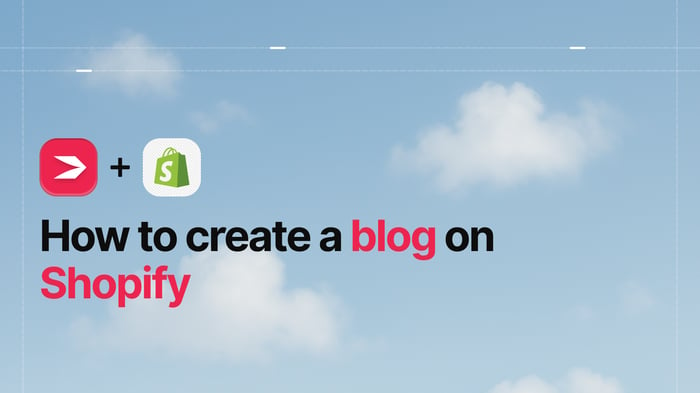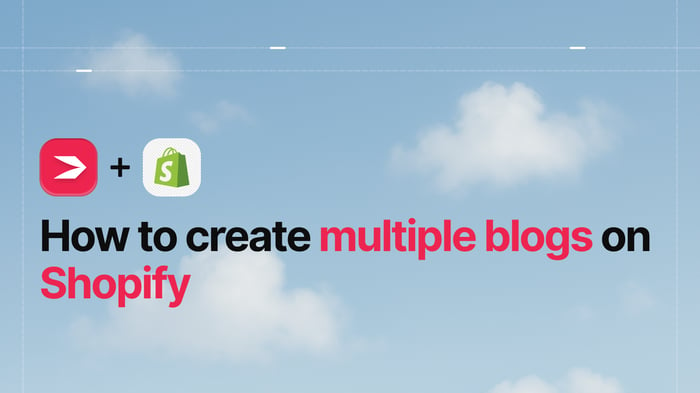Shopify and Etsy are clear examples of two diametrically opposed e-commerce models.
The first platform provides you with all the necessary tools to build your e-commerce store from the ground up. Shopify gives you all the materials, tools, and guidelines, but you are the one who builds the store and takes care of all the facets of your online business.
In contrast to this, Etsy is like a giant marketplace – you’ll hear this metaphor over and over again – where you hold a stand/booth/stall to showcase and sell your products. Everything has been taken care of for you by the marketplace itself. You just need to prepare and display your products, assign the prices, and inform potential buyers about any additional costs (for instance, shipping) or include them in the product’s price.
With Etsy, you don’t own a separate store. You sell along with all the other sellers at the marketplace, side by side with your competitors.
So, which model is better?
Well, they both have advantages and disadvantages, and, as predictable as this answer may be, it really depends on what you sell, how much time and energy you want to invest in your business, and what your objectives and needs are. In addition to this, individual variations within the same model need to be taken into consideration since, for instance, not every virtual marketplace platform is the same, like eBay, Amazon, and Etsy clearly show.
So, let’s dive deeper into the differences, pros and cons, perks, and inner workings of Shopify and Etsy, and see which of the two platforms has the upper hand, if at all, in a Shopify vs. Etsy showdown.
Table of Contents
Who Is Shopify For?
Shopify would be best for someone who already has a loyal customer base. For instance, if you started on another platform, created your e-commerce store there, and, in time, managed to build your own audience, you can migrate to Shopify in search of an ultra-scalable platform and take your customers with you.
This way you won’t have to go through the hassle of working out ways to drive traffic to your site and building an audience from scratch. Eventually, building everything from scratch might be extremely rewarding, but the path that leads there can be very challenging and frustrating, as some entrepreneurs confess. You should never underestimate how demanding building your customer base can be.
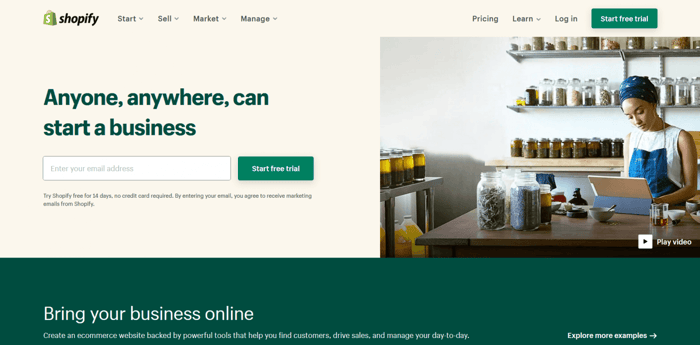
One caveat though. Probably anyone who has migrated from one platform to another would confirm that this can be a terrible headache. The process and logistics are usually pretty complex and, besides this, it’s highly probable that it’ll take some time for your customers to get used to the new look and feel of your store. So, bear in mind that migration can be messy. The ideal thing would be to do sufficient research, take your time, see what works best for you, if it’s an option, test-drive the platform before you make the final decision, and only then build your e-commerce store/shop.
Shopify is also for entrepreneurs who are very serious about their business and have a long-term plan and full-time commitment to their e-commerce store. Since Shopify is more complex to use compared to Etsy, it’s recommended that you already have some experience in online sales and marketing.
Who Is Etsy For?
Etsy is best suited for someone who is about to start selling online for the first time. You just need to set up an account, list your products, and you’re all set to embark on your online business journey. It’s ideal for the absolute beginner.
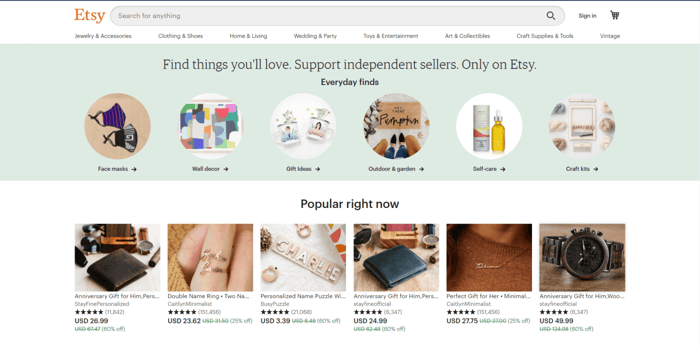
Etsy is also good as a side gig if you don’t plan on your online business being your bread and butter – at least not right from the beginning – but potentially an additional source of income. However, before you even start, you should do the math and see if it would be cost-effective for you to open an Etsy shop, taking into account all the fees you need to pay (more on this later).
Etsy is excellent if you want to sell your handicraft, unique handmade artwork, or similar creative work. Actually, this is one of the first things that comes to mind when someone mentions Etsy.
It also works perfectly for people with low budgets and those who don’t want to have big upfront costs.
The Pros and Cons of Etsy and Shopify
Etsy
Pros
Built-in audience
At Etsy, you instantly have access to a large customer base, so you don’t need to focus on driving traffic to your selling space.
Etsy gets so much traffic thanks to paid ads (that’s how the company invests at least part of the money it earns in fees from Etsy sellers) and smart SEO. Also, Etsy ranks very high on search engines’ lists and attracts many visitors because it’s an enormous marketplace with hundreds of thousands of sellers.
Another source of traffic is the accounts Etsy sellers have on other selling platforms and social media that they use for marketing purposes. They bring their own audiences to the Etsy marketplace, but they’re not the only ones who reap the benefits. The company definitely profits from this, but other owners of Etsy shops can gain a lot too.

Credibility
When you sell on Etsy, you seem like a trustworthy seller. In a way, the fact that your products are sold on Etsy guarantees this. The positive consequence is that you don’t need to work on gaining the trust of the audience. It’s already there.
Convenient messaging system
Etsy makes it very easy to communicate with your customers via a built-in messaging system. So, if you need to inform them of anything related to your products or if they have any questions regarding your goods, it’s a breeze to contact each other and make all the necessary arrangements and clarifications.
Etsy takes care of the technical stuff so you don’t have to
Thanks to the insights from the extremely large amount of data Etsy has on its users and sales, the company provides everything necessary for high conversion rates. You don’t need to be concerned with marketing, checkout pages, payment gateways, or any other technical facets of running an e-commerce business. Etsy has already done it for you, so you don’t have to.
Low starting costs
Actually, it’s free to set up an account and open a shop on Etsy. However, there’s a catch: you pay for every listing – the fee is $0.20 per listing – and every time someone buys a product, Etsy charges an additional $0.20 renewal fee. For example, if you list 3 products at once, Etsy will charge you 20 cents for all 3 products. However, when you sell one of them, the listing auto-renews, so you’ll be charged an additional 20 cents to be able to sell the remaining 2 products. The same thing happens every time you sell a product. Check out this Etsy page for a more detailed explanation of this system. There are other costs too, but more on that later.
Anyway, the starting costs for Etsy are very low. This is what makes it so appealing to many creatives with low investment capabilities and, probably, one of the main factors that contributes to Etsy’s popularity.
Streamlined and extremely easy-to-use dashboard
This is self-explanatory. You don’t need to learn anything in particular when it comes to using the Etsy dashboard. It’s intuitive and simple and requires almost zero technical knowledge.
Cons
Abrupt account deactivation
This is one of the scariest things reported about Etsy. In my research, I came across more than a few Etsy users who experienced this first hand. And these are not isolated cases or just negligible incidents. There are some nightmare stories out there about Etsy shop owners going through rough times due to Etsy deactivating their accounts without previously notifying them, with no warnings, explanation, or for no logical and apparent reasons.
There’s this one example where an Etsy shop owner’s account was abruptly deactivated for no obvious reasons. As this was a huge shocker for the owner, they reached out to the Etsy customer service through email and by phone several times, but never really got an answer as to why the company decided to deactivate their account, so they lost their business literally overnight.
There must be a rationale for this action on Etsy’s side, and it’s most probably related to violations of the company’s terms and conditions. For instance, someone may report your product for copyright infringement or similar, and get your account suspended.
However, the problem is that Etsy hasn’t been transparent at all about this, so even if the Etsy shop owners were doing something wrong presumably unintentionally, they couldn’t get any information on it nor could they get a chance to redeem themselves and recover their accounts and businesses.
To me, this is the biggest con of Etsy.
Too many fees
We saw that the starting fees for Etsy are low, but in the long run, Etsy may turn out to be very costly. This is one of the company’s aspects that’s the most frequent target of clients complaints.
For starters, there are so many fees, reviewers report that sometimes it’s difficult to understand what they are charged for. There are listing fees, renewal fees, shipping fees, transaction fees (Etsy takes away from your earnings every time you sell something), advertising and promotional fees, and more. There’s a whole page dedicated to this, so you should explore the Etsy payment system before getting started.
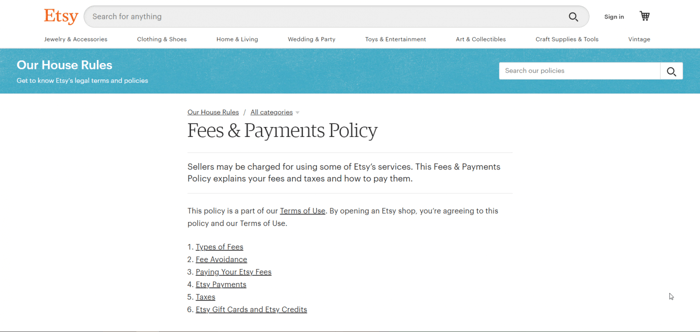
The most peculiar type of fee is probably the renewal fee. Every time someone buys a product from you, your listing auto-renews and the company charges 20 cents for this service. Again, the thing is that this is not as transparent as you’d want it to be. I mean, you’ll find the information, but with Etsy, you’ll have to get into the habit of always reading the fine print. There are some useful Etsy fee calculators out there, so find one and use it every time you want to know the exact amount of money that Etsy charges for your products.
In addition to regular fees, if you earn more than 10K per year, Etsy will take a 15% higher fee.
No consistent traffic and sales
With Etsy, you start afresh every single day. Every day you’re back to square one. There are examples of sellers not being able to sell anything for long periods.
The main reason for this is that, yes, there’s a built-in audience, but it’s not your audience. If a visitor finds a better bargain, meaning cheaper shipping or products, they’ll buy from your competitors. Nothing guarantees that someone will buy from your exact shop.
On a colossal marketplace like Etsy, it’s rare to have something along the lines of recurrent sales to recurrent customers, unless it's the audience you brought with you from social media or another e-commerce platform.
Anonymity
At Etsy, sellers get lost in anonymity. The bulk of the time people just buy on Etsy, not from you. More often than not they don’t even notice or remember the exact shop where they bought a product. This makes the process of building your own branding extremely difficult.
Lack of customization and control
Etsy doesn’t provide customization options. The only two things that you can set up yourself are your banner and your profile picture, which means that you don’t have any control over the design of your shop.
But this goes much further than just design and creative control. Etsy sellers lack control over so many other aspects of their online businesses. For instance, if Etsy introduces any novelties that might damage your business, you can’t do anything about it. If Etsy changes its algorithms and this affects how many people visit your shop and buy from you, you don’t have a say in the matter. You just need to passively accept the changes.
For example, in 2019, Etsy decided to favor sellers who offered free shipping. This was good for Etsy’s overall sales, but not quite fair to all the sellers. Some of the Etsy shop owners were not in a good position to offer free shipping, for different reasons; let’s say if they were selling bigger and heavier products. This automatically puts them in a worse position and gives a big head start to the other competitors. The worst part was that they couldn’t do anything about it.
No differentiation between Etsy shops
There’s not much differentiation between Etsy sellers. The products of your competition are shown on the same page with your products. So, if someone is scrolling down the page looking at your products, they can see the same type of products from other shops too, which is not the most desirable thing for your business.

Shopify
Pros
Your own personal store
With Shopify, you can build your own, stand-alone e-commerce store and you have control over the data, design, shipping, prices, marketing, and every other aspect of your online business.
Shopify offers a host of free and paid responsive templates, specially designed for different industries, and a drag-and-drop editor where you can tweak your storefront. In addition to this, for the tech-savvy, the platform allows its customers to experiment with the code and give that extra ounce of personalization to their stores.
Shopify also provides a custom domain and a business name generator, which, in addition to the customization options, allows you to be creative and build your branding exactly how you want it, so you can make your personal store stand out from the crowd in every possible sense.
Organized pricing system
With Shopify, the pricing system is much more organized and easier to grasp, compared to Etsy’s.
There’s a fixed monthly or yearly fee, exact fees for paid add-ons (if you want to add more functionality), and clear information on the transaction fees, so you know what you pay for and exactly how much you pay.
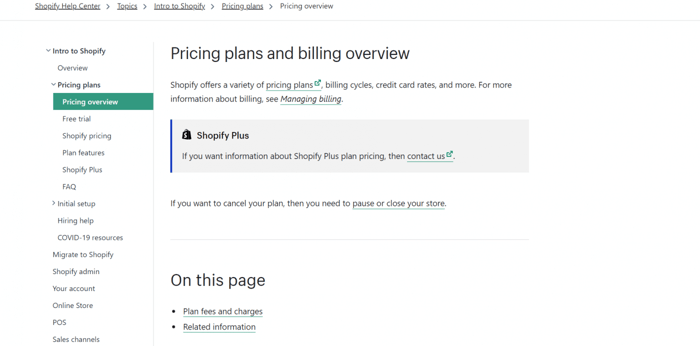
In the long run, Shopify turns out to be cheaper, although this might sound counter-intuitive, and it’s exactly because of its fixed and transparent pricing.
Shopify App Store
One of the best things about Shopify is its app store. With more than 6,000 available integrations, free and paid, it’s a place where you can find apps for whatever you want: marketing, customer support, shipping, blogging, finances, reporting, and more.
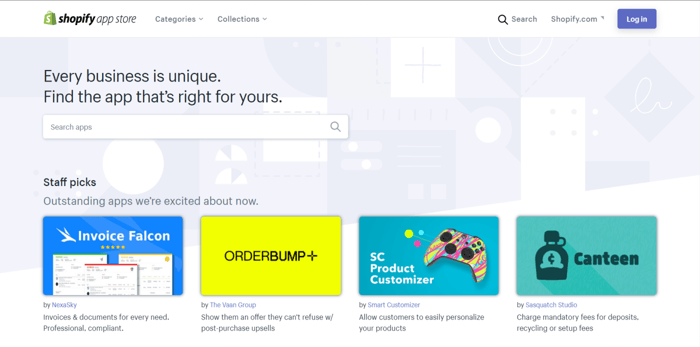
Let’s take blogging as an example. Since blogging is a terrific way to boost your SEO rankings, become more personal with your clients, and improve your business generally, it’s one of the must-haves of today’s online businesses. It takes only a few minutes to find a high-quality blogging solution for your e-commerce store. You can add the superb blogging tool DropInBlog directly from your Shopify account (the app store). Connect your blog with your Shopify e-commerce store, and start blogging and selling more products in no time.
Great customer service
The Shopify customer service holds very high ratings. In the experience of the majority of Shopify clients, the company provides great around-the-clock help and support (via email, real-time live chat, and phone), and the members of its customer service team are considered to be friendly, professional, responsive, helpful, and proactive. Based on the experience of Etsy sellers whose shops were abruptly deactivated, this can not be said about the Etsy customer service staff.
Terrific sales and marketing features
Shopify offers so much in terms of features and tools, like promotions, analytics, a point-of-sale system for online and offline selling, shipping, SEO, payment processing, a marketplace, abandoned cart recovery, discounts, multiple languages, payment processing in 133 currencies, and so on.
Cons
Build your own audience
This is one of the few Shopify cons that keeps reemerging in users’ reviews.
It may sound like it’s not, but again, driving traffic to your site, keeping visitors’ attention, and building your own customer base can be a long and arduous process. It takes time, energy, persistence, and a lot of learning through trial and error to spread the word about your products and gain loyal customers.
Everything depends on the store owner
The same thing that can be an advantage for some, can be a burden and a big problem for others, like in this case. With a Shopify stand-alone store, you have to work on marketing, SEO, conversions, sales strategies, and similar by yourself. It goes without saying that these are time-consuming and not simple things to do, although platforms like Shopify try to make the whole process as smooth as possible for its customers.
Higher starting costs
This is one of the biggest cons of Shopify.
The company offers three regular pricing plans:
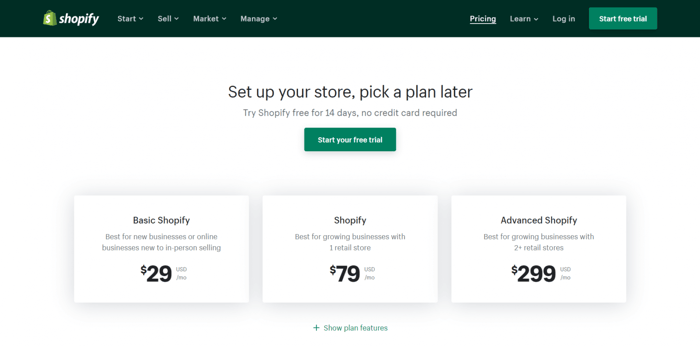
Obviously, with respect to this, there’s a big difference between Shopify and Etsy. Not everyone can afford to pay this much right from the start. Actually, this is what many reviewers say played a key role in choosing Etsy over Shopify. If you’re on a tight budget, or you’re just dipping your toes in the water, or you’re not sure if your business endeavor will be cost-effective, paying even for the Basic Shopify plan may look like too adventurous of a move.
Final Thoughts
Shopify and Etsy appeal to people for different reasons. Although there’s overlap, they mostly appeal to different categories of users. They both have good sides and downsides that can be deal-breakers. And as we saw in this Shopify vs Etsy comparison, sometimes the same thing can be both, an advantage and a disadvantage, depending on the context and personal perspective of the user.
Which one is more appealing to you? And, even more important, which one of the two platforms is better suited to your needs and business? I hope this Shopify vs. Etsy article helps you come to a straightforward answer to this question.



